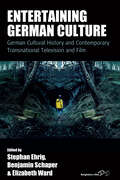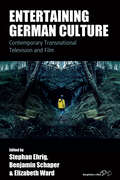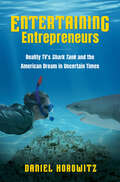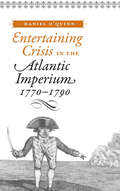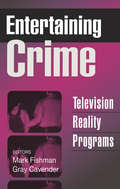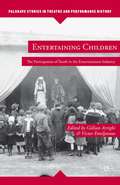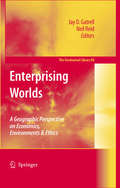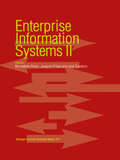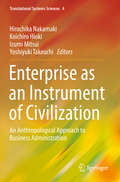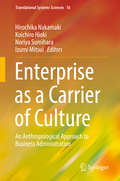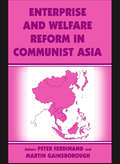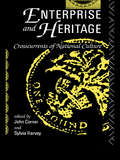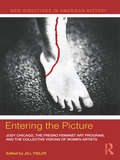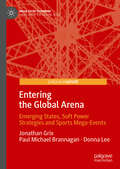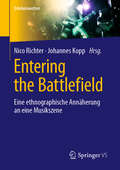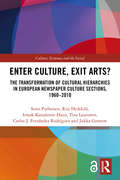- Table View
- List View
Entertaining Judgment: The Afterlife in Popular Imagination
by Greg GarrettNowadays references to the afterlife-angels strumming harps, demons brandishing pitchforks, God enthroned on heavenly clouds-are more often encountered in New Yorker cartoons than in serious Christian theological reflection. Speculation about death and its sequel seems to embarrass many theologians; however, as Greg Garrett shows in Entertaining Judgment, popular culture in the U.S. has found rich ground for creative expression in the search for answers to the question: What lies in store for us after we die? The lyrics of Madonna, Los Lonely Boys, and Sean Combs; the plotlines of TV's Lost, South Park, and The Walking Dead; the implied theology in films such as The Dark Knight, Ghost, and Field of Dreams; the heavenly half-light of Thomas Kinkade's popular paintings; the ghosts, shades, and after-life way-stations in Harry Potter; and the characters, situations, and locations in the Hunger Games saga all speak to our hopes and fears about what comes next. In a rich survey of literature and popular media, Garrett compares cultural accounts of death and the afterlife with those found in scripture. Denizens of the imagined afterlife, whether in heaven, hell, on earth, or in purgatory, speak to what awaits us, at once shaping and reflecting our deeply held-if often somewhat nebulous-beliefs. They show us what rewards and punishments we might expect, offer us divine assistance, and even diabolically attack us. Ultimately, we are drawn to these stories of heaven, hell, and purgatory--and to stories about death and the undead--not only because they entertain us, but because they help us to create meaning and to learn about ourselves, our world, and, perhaps, the next world. Garrett's deft analysis sheds new light on what popular culture can tell us about the startlingly sharp divide between what modern people profess to believe and what they truly hope and expect to find after death--and how they use those stories to help them understand this life.
Entertaining German Culture: Contemporary Transnational Television and Film (Film Europa #27)
by Stephan Ehrig Benjamin Schaper Elizabeth WardAudiences for contemporary German film and television are becoming increasingly transnational, and depictions of German cultural history are moving beyond the typical post-war focus on Germany’s problematic past. Entertaining German Culture explores this radical shift, building on recent research into transnational culture to argue that a new process of internal and external cultural reabsorption is taking place through areas of mutually assimilating cultural exchange such as streaming services, an increasingly international film market, and the import and export of Anglo-American media formats.
Entertaining German Culture: Contemporary Transnational Television and Film (Film Europa #27)
by Stephan Ehrig, Benjamin Schaper Elizabeth WardAudiences for contemporary German film and television are becoming increasingly transnational, and depictions of German cultural history are moving beyond the typical post-war focus on Germany’s problematic past. Entertaining German Culture explores this radical shift, building on recent research into transnational culture to argue that a new process of internal and external cultural reabsorption is taking place through areas of mutually assimilating cultural exchange such as streaming services, an increasingly international film market, and the import and export of Anglo-American media formats.
Entertaining Entrepreneurs: Reality TV's Shark Tank and the American Dream in Uncertain Times
by Daniel HorowitzThe Great Recession threatened the well-being of tens of millions of Americans, dramatically weakened the working class, hollowed out the middle class, and strengthened the position of the very wealthy. Against this backdrop, the hit reality show Shark Tank premiered in 2009. Featuring ambitious entrepreneurs chasing support from celebrity investors, the show offered a version of the American Dream that still seemed possible to many, where a bright idea and a well-honed pitch could lift a bootstrap business to new heights of success. More than a decade later, Shark Tank still airs regularly on multiple networks, and its formula has sparked imitators everywhere, from elite universities to elementary school classrooms. In Entertaining Entrepreneurs, Daniel Horowitz shows how Shark Tank's version of entrepreneurship disguises and distorts the opportunities and traps of capitalism. Digging into today's cult of the entrepreneur, Horowitz charts its rise from the rubble of economic crisis and its spread as a mainstay of American culture, and he explores its flawed view of what it really takes to succeed in business. Horowitz offers more than a look at one television phenomenon. He is the perfect guide to the portrayal of entrepreneurship in business school courses, pitch competitions, popular how-to books, and scholarly works, as well as the views of real-world venture capitalists.
Entertaining Crisis in the Atlantic Imperium, 1770–1790
by Daniel O'QuinnLess than twenty years after asserting global dominance in the Seven Years' War, Britain suffered a devastating defeat when it lost the American colonies. Daniel O'Quinn explores how the theaters and the newspapers worked in concert to mediate the events of the American war for British audiences and how these convergent media attempted to articulate a post-American future for British imperial society.Building on the methodological innovations of his 2005 publication Staging Governance: Theatrical Imperialism in London, 1770-1800, O’Quinn demonstrates how the reconstitution of British imperial subjectivities involved an almost nightly engagement with a rich entertainment culture that necessarily incorporated information circulated in the daily press. Each chapter investigates different moments in the American crisis through the analysis of scenes of social and theatrical performance and through careful readings of works by figures such as Richard Brinsley Sheridan, William Cowper, Hannah More, Arthur Murphy, Hannah Cowley, George Colman, and Georg Friedrich Handel. Through a close engagement with this diverse entertainment archive, O'Quinn traces the hollowing out of elite British masculinity during the 1770s and examines the resulting strategies for reconfiguring ideas of gender, sexuality, and sociability that would stabilize national and imperial relations in the 1780s. Together, O'Quinn's two books offer a dramatic account of the global shifts in British imperial culture that will be of interest to scholars in theater and performance studies, eighteenth-century studies, Romanticism, and trans-Atlantic studies.
Entertaining Crime: Television Reality Programs
by Mark FishmanIn eleven original studies by social scientists, this is the first volume to focus on television reality crime programming as a genre. Contributors address such questions as: why do these programs exist; what larger cultural meaning do they have; what effect do they have on audiences; and what do they indicate about crime and justice in the late twentieth century? Adaptable at both undergraduate and graduate levels, Entertaining Crime will contribute to discussions of crime and the media, as well as crime in relation to other issues, such as gender, race/ethnicity, and fear of crime.
Entertaining Crime: Television Reality Programs
by Mark FishmanIn eleven original studies by social scientists, this is the first volume to focus on television reality crime programming as a genre. Contributors address such questions as: why do these programs exist; what larger cultural meaning do they have; what effect do they have on audiences; and what do they indicate about crime and justice in the late twentieth century? Adaptable at both undergraduate and graduate levels, Entertaining Crime will contribute to discussions of crime and the media, as well as crime in relation to other issues, such as gender, race/ethnicity, and fear of crime.
Entertaining Children: The Participation of Youth in the Entertainment Industry (Palgrave Studies in Theatre and Performance History)
by Gillian Arrighi Victor EmeljanowChildren have been exploited as performers and wooed energetically as consumers throughout history. These essays offer scholarly investigations into the employment and participation of children in the entertainment industry with examples drawn from historical and contemporary contexts.
Enterprising Worlds: A Geographic Perspective on Economics, Environments & Ethics (GeoJournal Library #86)
by Jay D. Gatrell Neil ReidThis book is the culmination of several years of work by geographers, planners, and economists. The chapters included in this volume represent the collective efforts of the International Geographical Union’s Commission on the Dynamics of Economic Spaces, at their 2005 annual meeting in Toledo, Ohio (USA). The papers were selected based on their contribution to the community of economic geographers and policymakers and to demonstrate the inherent interconnectedness of these themes.
Enterprising care?: Unpaid voluntary action in the 21st century
by Irene Hardill Susan BainesMore and more is being expected of volunteers and the voluntary sector in the UK. But what does it mean to be a volunteer today? This book seeks to add new insights into individual action in that part of the economy that is beyond the state and the market. Volunteering is examined from the perspective of the individual, the organisation, and the community (of place, identity or interest).
Enterprise Unionism In Japan
by Hirosuke KawanishiDuring the 1980s many Japanese began to feel the pressures of ‘internationalizing.’ At the same time, Japanese-style industrial relations came to receive wide international attention. For most people ‘Japanese-style industrial relations’ came to mean the ‘three sacred treasures’: lifetime employment, seniority wages and enterprise unionism. During the 1980s many Japanese began to feel the pressures of ‘internationalizing.’ At the same time, Japanese-style industrial relations came to receive wide international attention. For most people ‘Japanese-style industrial relations’ came to mean the ‘three sacred treasures’: lifetime employment, seniority wages and enterprise unionism.
Enterprise Unionism In Japan
by Hirosuke KawanishiDuring the 1980s many Japanese began to feel the pressures of ‘internationalizing.’ At the same time, Japanese-style industrial relations came to receive wide international attention. For most people ‘Japanese-style industrial relations’ came to mean the ‘three sacred treasures’: lifetime employment, seniority wages and enterprise unionism. During the 1980s many Japanese began to feel the pressures of ‘internationalizing.’ At the same time, Japanese-style industrial relations came to receive wide international attention. For most people ‘Japanese-style industrial relations’ came to mean the ‘three sacred treasures’: lifetime employment, seniority wages and enterprise unionism.
Enterprise Information Systems II
by Bernadette Sharp Joaquim Filipe José CordeiroThis book comprises the refereed papers together with the invited keynote papers, presented at the Second International Conference on Enterprise Information Systems. The conference was organised by the School of Computing at Staffordshire University, UK, and the Escola Superior de Tecnologia of Setubal, Portugal, in cooperation with the British Computer Society and the International Federation for Information Processing, Working Group 8.1. The purpose of this 2nd International Conference was to bring together researchers, engineers and practitioners interested in the advances in and business applications of information systems. The papers demonstrate the vitality and vibrancy of the field of Enterprise Information Systems. The research papers included here were selected from among 143 submissions from 32 countries in the following four areas: Enterprise Database Applications, Artificial Intelligence Applications and Decision Support Systems, Systems Analysis and Specification, and Internet and Electronic Commerce. Every paper had at least two reVIewers drawn from 10 countries. The papers included in this book were recommended by the reviewers. On behalf of the conference organising committee we would like to thank all the members of the Programme Committee for their work in reviewing and selecting the papers that appear in this volume. We would also like to thank all the authors who have submitted their papers to this conference, and would like to apologise to the authors that we were unable to include and wish them success next year.
Enterprise as an Instrument of Civilization: An Anthropological Approach to Business Administration (Translational Systems Sciences #4)
by Hirochika Nakamaki Koichiro Hioki Izumi Mitsui Yoshiyuki TakeuchiIn this book, the functions and dynamics of enterprises are explained with the use of anthropological methods. The chapters are based on anthropological research that has continued mainly as an inter-university research project, which is named Keiei Jinruigaku, of the National Museum of Ethnology (Japan) since 1993. These studies have a twofold aim: to clarify that enterprises are not only actors in economic activity but also actors that create culture and civilization; and to find the raison d'être of enterprises in a global society. Business anthropology is an approach to the investigation of various phenomena in enterprises and management using anthropological methodology (e.g., participant observations and interviews). Historically, its origin goes back to the 1920s–30s. In the Hawthorne experiments, the research group organized by Elton Mayo recruited an anthropologist, Lloyd W. Warner, and conducted research on human relations in the workplace by observation of participants. Since then, similar studies have been carried out in the United States and the United Kingdom. In Japan, however, such research is quite rare. Now, in addition to anthropological methods, the authors have employed multidisciplinary methods drawn from management, economics, and sociology. The research contained here can be characterized in these ways: (1) Research methods adopt interpretative approaches such as hermeneutic and/or narrative approaches rather than causal and functional explanations such as “cause–consequence” relationships. (2) Multidisciplinary approaches including qualitative research techniques are employed to investigate the total entity of enterprises, with their own cosmology. In this book, the totality of activities by enterprises are shown, including the relationship between religion and enterprise, corporate funerals, corporate museums, and the sacred space and/or mythology of enterprises. Part I provides introductions to Keiei Jinruigaku and Part II explains the theoretical characteristics of Keiei Jinruigaku. In addition, research topics and cases of Keiei Jinruigaku are presented in Part III.
Enterprise as a Carrier of Culture: An Anthropological Approach to Business Administration (Translational Systems Sciences #16)
by Hirochika Nakamaki Koichiro Hioki Izumi Mitsui Noriya SumiharaThis book expands anthropological studies of business enterprise to include comparative and interdisciplinary perspectives. A number of books on business anthropology have been published, but most of them are written by anthropologists alone. By contrast, this book engages interdisciplinary studies, e.g., not only by anthropologists but also management scholars and other social scientists. It is the second volume of studies forwarding anthropological approaches to business administration, Keiei Jinruigaku. This volume focusses on the cultural dimensions of enterprise. Here enterprise is viewed as a medium carrying culture, rather than solely an entity of production and management, as is typical in mainstream studies. The approach is based on Tadao Umesao’s definition of culture as a projection of instruments/devices and institutions into the mental/spiritual dimensions of life. Therefore, in our view production and management are among the projections of the cultural aspects of enterprise. This perspective, we believe, constitutes a new frontier in the study of business administration. This book consists of three parts, the first being “religiosity and spirituality”, the second “exhibitions, performance and inducement,” and the third “history and story.” In Part I, Quaker Codes, ex-votos, and spiritual leadership are discussed in relation to management and behavior, and miracles and pilgrimage. Part II describes exhibitions justifying nuclear power industry within power plants in both Japan and England, the exhibition by English families of their porcelain collections, and the performance skills of orchestral maestros. All of these examples indicate that, through the use of narratives and myths, exhibits and performances overtly and covertly induce visitors or audiences to certain viewpoints and emotions. Part III offers examples of histories and stories of enterprise articulated through the branding and consumption of industrial products, and their display in enterprise museums where the essence of culture and heritage is cherished and emphasized, by and for the wider community and the enterprise itself. Conjoined as an interdisciplinary team of Western and Japanese researchers, we apply an anthropological approach to the cultural history of enterprise in both Britain and Japan.
Enterprise and Welfare Reform in Communist Asia
by Peter Ferdinand Martin GainsboroughFeaturing a wide geographical scope, this collection of essays surveys enterprise and welfare reforms in all the remaining four Asian communist states: China, Vietnam, Laos and North Korea. Since the collapse of the Soviet Union they can no longer place major reliance upon assistance from other 'fraternal' states and have to devise their own strategies for survival. All have shown a trend towards greater reliance on market forces, though in different ways and to varying degrees. Enterprise management has to adapt to this. In some of them entrepreneurs have become politically and socially acceptable. They may even begin to set trends for social evolution. Yet since state entreprises used to be responsible for all welfare payments to employees and their families, management reforms cannot be separated from those of welfare arrangements. Reducing an enterprise's non-commerical obligations for the sake of greater market efficiency is bound to affect welfare provision. It also reopens the role of official trade unions. How these regimes cope with these conflicting pressures are vital factors in their long-term viability.
Enterprise and Welfare Reform in Communist Asia
by Peter Ferdinand Martin GainsboroughFeaturing a wide geographical scope, this collection of essays surveys enterprise and welfare reforms in all the remaining four Asian communist states: China, Vietnam, Laos and North Korea. Since the collapse of the Soviet Union they can no longer place major reliance upon assistance from other 'fraternal' states and have to devise their own strategies for survival. All have shown a trend towards greater reliance on market forces, though in different ways and to varying degrees. Enterprise management has to adapt to this. In some of them entrepreneurs have become politically and socially acceptable. They may even begin to set trends for social evolution. Yet since state entreprises used to be responsible for all welfare payments to employees and their families, management reforms cannot be separated from those of welfare arrangements. Reducing an enterprise's non-commerical obligations for the sake of greater market efficiency is bound to affect welfare provision. It also reopens the role of official trade unions. How these regimes cope with these conflicting pressures are vital factors in their long-term viability.
Enterprise and Heritage: Crosscurrents of National Culture
by John CornerThe phenomena of `enterprise' and `heritage' might at first thought seem unrelated: this book sets out to show that the two concepts are not only related but deeply interdependent. If `enterprise' can be used to define the official encouragement of the values of the market society, then the growth of the heritage industry can be seen as a manifestation of the entrepreneurial spirit - marketing the past so that it is accessible to the man or woman in the street. Using case studies, commentary and critique, the contributors to this lively volume discuss the importance of `enterprise' and `heritage' in British social and cultural life, with examples drawn from film, television, literature, urban planning, architecture, government advertising, information technology and tourism.
Enterprise and Heritage: Crosscurrents of National Culture
by John Corner Sylvia HarveyThe phenomena of `enterprise' and `heritage' might at first thought seem unrelated: this book sets out to show that the two concepts are not only related but deeply interdependent. If `enterprise' can be used to define the official encouragement of the values of the market society, then the growth of the heritage industry can be seen as a manifestation of the entrepreneurial spirit - marketing the past so that it is accessible to the man or woman in the street. Using case studies, commentary and critique, the contributors to this lively volume discuss the importance of `enterprise' and `heritage' in British social and cultural life, with examples drawn from film, television, literature, urban planning, architecture, government advertising, information technology and tourism.
Entering the Picture: Judy Chicago, The Fresno Feminist Art Program, and the Collective Visions of Women Artists (New Directions in American History)
by Jill FieldsIn 1970, Judy Chicago and fifteen students founded the groundbreaking Feminist Art Program (FAP) at Fresno State. Drawing upon the consciousness-raising techniques of the women's liberation movement, they created shocking new art forms depicting female experiences. Collaborative work and performance art – including the famous "Cunt Cheerleaders" – were program hallmarks. Moving to Los Angeles, the FAP produced the first major feminist art installation, Womanhouse (1972). Augmented by thirty-seven illustrations and color plates, this interdisciplinary collection of essays by artists and scholars, many of whom were eye witnesses to landmark events, relates how feminists produced vibrant bodies of art in Fresno and other locales where similar collaborations flourished. Articles on topics such as African American artists in New York and Los Angeles, San Francisco’s Las Mujeres Muralistas and Asian American Women Artists Association, and exhibitions in Taiwan and Italy showcase the artistic trajectories that destabilized traditional theories and practices and reshaped the art world. An engaging editor’s introduction explains how feminist art emerged within the powerful women’s movement that transformed America. Entering the Picture is an exciting collection about the provocative contributions of feminists to American art.
Entering the Picture: Judy Chicago, The Fresno Feminist Art Program, and the Collective Visions of Women Artists (New Directions in American History)
by Jill FieldsIn 1970, Judy Chicago and fifteen students founded the groundbreaking Feminist Art Program (FAP) at Fresno State. Drawing upon the consciousness-raising techniques of the women's liberation movement, they created shocking new art forms depicting female experiences. Collaborative work and performance art – including the famous "Cunt Cheerleaders" – were program hallmarks. Moving to Los Angeles, the FAP produced the first major feminist art installation, Womanhouse (1972). Augmented by thirty-seven illustrations and color plates, this interdisciplinary collection of essays by artists and scholars, many of whom were eye witnesses to landmark events, relates how feminists produced vibrant bodies of art in Fresno and other locales where similar collaborations flourished. Articles on topics such as African American artists in New York and Los Angeles, San Francisco’s Las Mujeres Muralistas and Asian American Women Artists Association, and exhibitions in Taiwan and Italy showcase the artistic trajectories that destabilized traditional theories and practices and reshaped the art world. An engaging editor’s introduction explains how feminist art emerged within the powerful women’s movement that transformed America. Entering the Picture is an exciting collection about the provocative contributions of feminists to American art.
Entering the Global Arena: Emerging States, Soft Power Strategies and Sports Mega-Events (Mega Event Planning)
by Jonathan Grix Paul Michael Brannagan Donna LeeSet against a backdrop of concerns about the potential break-up or radical change to the global world order, this volume sets out to investigate the use of sports mega-events by a number of emerging states.Sports mega-events, it is argued, can be understood as a key component in states’ ‘soft power’ strategies, that is, their attempts to showcase their nations on the international stage, increase their power relative to others via non-coercive means and to increase trade and tourism. Many studies on soft power simply cite the concept’s founder (Joseph Nye) and make little attempt at unpicking the mechanisms behind its creation. This volume does this by shining a light on emerging economies and by putting forward a soft power ‘ideal type’ to aid researchers in understanding the strategies employed by states in advancing their interests.
Entering the Battlefield: Eine ethnographische Annäherung an eine Musikszene (Erlebniswelten)
by Nico Richter Johannes KoppModerne Gesellschaften bestehen aus einer Vielzahl von Lebenswelten. Diese besitzen aber spezifische kulturelle Eigenheiten, die sich einem Verständnis und somit auch einer wissenschaftlichen Erfassung von außen teilweise entziehen. Szenen dienen dabei als hilfreiches Konzept, um diese gesellschaftlich relevanten Gebilde fassbar zu machen. Hierzu bedarf es zunächst einer Annäherung und Beschreibung der kulturellen Eigenheiten aus der Binnenperspektive. Gegenstand des vorliegenden Buches ist die Szene des Heavy-Metal bzw. ihre Manifestation im Rahmen eines Festivals. Mit Hilfe ethnographischer Methoden werden die unterschiedlichsten szenespezifischen Phänomene anhand konkreter Situationen – etwa in den unterschiedlichsten Formen des Campens über ritualisierte Verhaltensweisen, das spezifische Konsumverhalten und die äußere Erscheinung der Protagonisten bis hin zur erstaunlichen Neigung zu beinahe konservativen Wertvorstellungen – beschrieben und untersucht. Zudem soll abschließend in einem Exkurs zu einer gänzlich anderen Szene gezeigt werden, wie viele erstaunliche Parallelen sich hinsichtlich der szenischen Vergemeinschaftung im Allgemeinen finden lassen.
Enter Culture, Exit Arts?: The Transformation of Cultural Hierarchies in European Newspaper Culture Sections, 1960–2010 (Open Access) (CRESC)
by Semi Purhonen Riie Heikkilä Irmak Karademir Hazir Tina Lauronen Carlos J. Fernández Rodríguez Jukka GronowKey debates of contemporary cultural sociology – the rise of the ‘cultural omnivore’, the fate of classical ‘highbrow’ culture, the popularization, commercialization and globalization of culture – deal with temporal changes. Yet, systematic research about these processes is scarce due to the lack of suitable longitudinal data. This book explores these questions through the lens of a crucial institution of cultural mediation – the culture sections in quality European newspapers – from 1960 to 2010. Starting from the framework of cultural stratification and employing systematic content analysis both quantitative and qualitative of more than 13,000 newspaper articles, Enter Culture, Exit Arts? presents a synthetic yet empirically rich and detailed account of cultural transformation in Europe over the last five decades. It shows how classifications and hierarchies of culture have changed in course of the process towards increased cultural heterogeneity. Furthermore, it conceptualizes the key trends of rising popular culture and declining highbrow arts as two simultaneous processes: the one of legitimization of popular culture and the other of popularization of traditional legitimate culture, both important for the loosening of the boundary between ‘highbrow’ and ‘popular’. Through careful comparative analysis and illustrative snapshots into the specific socio-historical contexts in which the newspapers and their representations of culture are embedded – in Finland, France, Spain, Sweden, Turkey and the UK – the book reveals the key patterns and diversity of European variations in the transformation of cultural hierarchies since the 1960s. The book is a collective endeavour of a large-scale international research project active between 2013 and 2018.
Enter Culture, Exit Arts?: The Transformation of Cultural Hierarchies in European Newspaper Culture Sections, 1960–2010 (Open Access) (CRESC)
by Semi Purhonen Riie Heikkilä Irmak Karademir Hazir Tina Lauronen Carlos J. Fernández Rodríguez Jukka GronowKey debates of contemporary cultural sociology – the rise of the ‘cultural omnivore’, the fate of classical ‘highbrow’ culture, the popularization, commercialization and globalization of culture – deal with temporal changes. Yet, systematic research about these processes is scarce due to the lack of suitable longitudinal data. This book explores these questions through the lens of a crucial institution of cultural mediation – the culture sections in quality European newspapers – from 1960 to 2010. Starting from the framework of cultural stratification and employing systematic content analysis both quantitative and qualitative of more than 13,000 newspaper articles, Enter Culture, Exit Arts? presents a synthetic yet empirically rich and detailed account of cultural transformation in Europe over the last five decades. It shows how classifications and hierarchies of culture have changed in course of the process towards increased cultural heterogeneity. Furthermore, it conceptualizes the key trends of rising popular culture and declining highbrow arts as two simultaneous processes: the one of legitimization of popular culture and the other of popularization of traditional legitimate culture, both important for the loosening of the boundary between ‘highbrow’ and ‘popular’. Through careful comparative analysis and illustrative snapshots into the specific socio-historical contexts in which the newspapers and their representations of culture are embedded – in Finland, France, Spain, Sweden, Turkey and the UK – the book reveals the key patterns and diversity of European variations in the transformation of cultural hierarchies since the 1960s. The book is a collective endeavour of a large-scale international research project active between 2013 and 2018.

